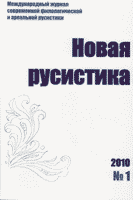Направления семантического развития генетически родственных слов (на примере цветообозначений в русском и чешском языках)
The Trend of the Semantic Development of the Genetically Related Words (Exemplified by the colour denotation)
Author(s): Lyudmila LebedevaSubject(s): Language and Literature Studies
Published by: Česká asociace slavistů
Keywords: russian; czech; languages; comparation; colour denotation; genetically related words
Summary/Abstract: The comparison of Russian and Czech genetically related colour naming adjectives that have common Slavonic roots reveals the following functional and semantic mechanisms: a) semantic development of words is generally the same – from colour meaning to derived non-colour meanings (желтый – žlutý, зеленый – zelený, черный – černý, белый – bílý); b) a word in one language preserves hte initialnon-colour meaning (krásný), and in another language it acquires new meanings – colour and non-colour (красный); c) genetically related words have a different number of meanings which is shown in the narrowing of the initial combinability of Russian words (червонный and гнедой) or in their dropping out from the active vocabulary (рудый/рудой) with constant widening of the corresponding Czech word (červený, rudý, hnědý).
Journal: Новая русистика
- Issue Year: 2010
- Issue No: 1
- Page Range: 45-54
- Page Count: 10
- Language: Russian

